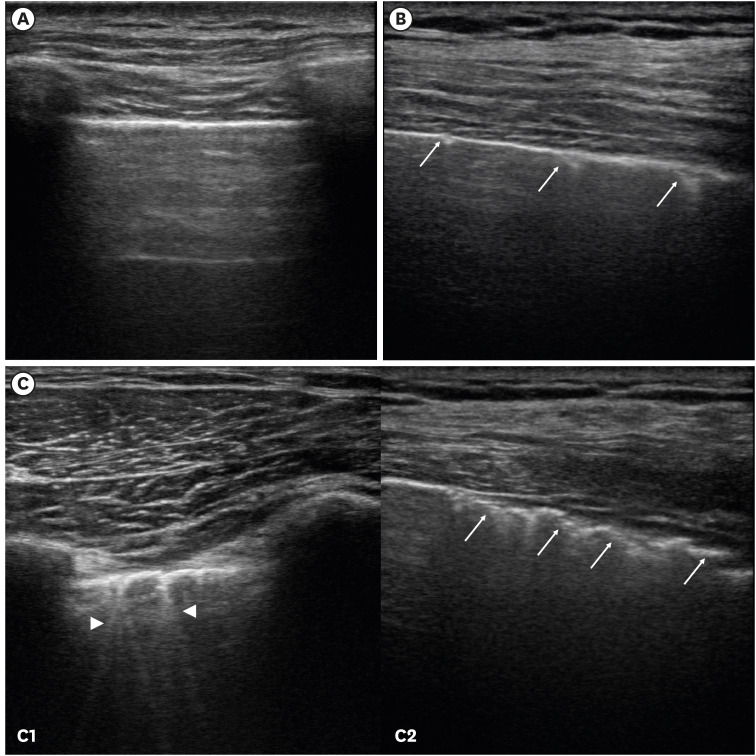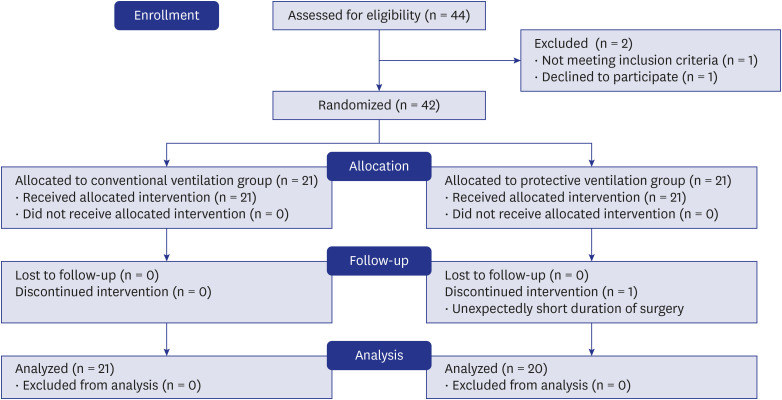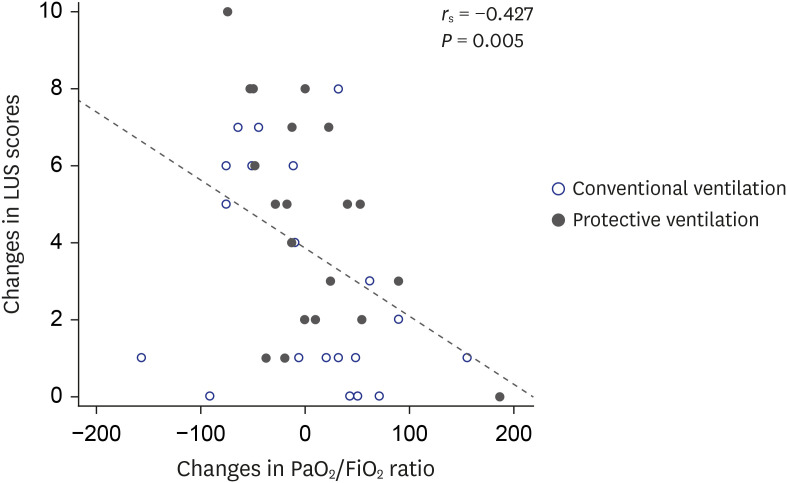J Korean Med Sci.
2020 Oct;35(39):e327. 10.3346/jkms.2020.35.e327.
Effects of Intraoperative Ventilation Strategy on Perioperative Atelectasis Assessed by Lung Ultrasonography in Patients Undergoing Open Abdominal Surgery: a Prospective Randomized Controlled Study
- Affiliations
-
- 1Department of Anesthesiology and Pain Medicine, Ewha Womans University, School of Medicine, Seoul, Korea
- 2Department of Anesthesiology and Pain Medicine, Ewha Womans University Mokdong Hospital, Seoul, Korea
- 3Department of Anesthesiology and Pain Medicine, Ewha Womans University Seoul Hospital, Seoul, Korea
- KMID: 2507607
- DOI: http://doi.org/10.3346/jkms.2020.35.e327
Abstract
- Background
Protective mechanical ventilation using low tidal volume has been introduced to surgical patients to reduce the incidence of postoperative pulmonary complications. We investigated the effects of protective ventilation (PV) techniques on anesthesia-induced atelectasis identified via lung ultrasonography in patients undergoing abdominal surgery.
Methods
A total of 42 adult patients who were scheduled for open abdominal surgery with an expected duration > 2 hours were included in the study. Patients were randomized to receive either conventional ventilation (CV; tidal volume of 9–10 mL/kg predicted body weight [PBW] with no positive end-expiratory pressure [PEEP]) or PV (tidal volume of 6–8 mL/kg PBW and 5 cmH 2 O PEEP) via pressure-controlled ventilation with volume guaranteed. Lung ultrasonography was performed at four predefined time points to assess perioperative atelectasis by dividing each hemithorax into six quadrants based on a modified lung ultrasound (LUS) scoring system.
Results
The tidal volume delivered to patients was 9.65 ± 1.65 mL/kg PBW in the CV group and 6.31 ± 0.62 mL/kg PBW in the PV group. Ventilation using low tidal volume led to similar LUS scores in all lung areas and at all time points compared to ventilation using high tidal volume. There was no significant difference between the groups in the number of patients requiring recruitment maneuvers at the end of surgery.
Conclusion
Ventilation with low tidal volume combined with 5 cmH2O PEEP did not cause further loss of aeration compared to ventilation with high tidal volume. Low tidal volume ventilation can be used in patients without lung injury based on lung assessment by bedside lung ultrasonography.
Figure
Cited by 1 articles
-
Assessment of Perioperative Atelectasis Using Lung Ultrasonography in Patients Undergoing Pneumoperitoneum Surgery in the Trendelenburg Position: Aspects of Differences according to Ventilatory Mode
Youn Young Lee, Jong In Han, Bo Kyung Kang, Kyungah Jeong, Jong Wha Lee, Dong Yeon Kim
J Korean Med Sci. 2021;36(50):e334. doi: 10.3346/jkms.2021.36.e334.
Reference
-
1. Cai H, Gong H, Zhang L, Wang Y, Tian Y. Effect of low tidal volume ventilation on atelectasis in patients during general anesthesia: a computed tomographic scan. J Clin Anesth. 2007; 19(2):125–129. PMID: 17379125.
Article2. Lundquist H, Hedenstierna G, Strandberg A, Tokics L, Brismar B. CT-assessment of dependent lung densities in man during general anaesthesia. Acta Radiol. 1995; 36(6):626–632. PMID: 8519574.
Article3. Putensen C, Theuerkauf N, Zinserling J, Wrigge H, Pelosi P. Meta-analysis: ventilation strategies and outcomes of the acute respiratory distress syndrome and acute lung injury. Ann Intern Med. 2009; 151(8):566–576. PMID: 19841457.
Article4. Bendixen HH, Hedley-Whyte J, Laver MB. Impaired oxygenation in surgical patients during general anesthesia with controlled ventilation. a concept of atelectasis. N Engl J Med. 1963; 269(19):991–996. PMID: 14059732.5. Güldner A, Kiss T, Serpa Neto A, Hemmes SN, Canet J, Spieth PM, et al. Intraoperative protective mechanical ventilation for prevention of postoperative pulmonary complications: a comprehensive review of the role of tidal volume, positive end-expiratory pressure, and lung recruitment maneuvers. Anesthesiology. 2015; 123(3):692–713. PMID: 26120769.6. Richard JC, Maggiore SM, Jonson B, Mancebo J, Lemaire F, Brochard L. Influence of tidal volume on alveolar recruitment. Respective role of PEEP and a recruitment maneuver. Am J Respir Crit Care Med. 2001; 163(7):1609–1613. PMID: 11401882.7. Serpa Neto A, Hemmes SN, Barbas CS, Beiderlinden M, Biehl M, Binnekade JM, et al. Protective versus conventional ventilation for surgery: a systematic review and individual patient data meta-analysis. Anesthesiology. 2015; 123(1):66–78. PMID: 25978326.8. Guay J, Ochroch EA, Kopp S. Intraoperative use of low volume ventilation to decrease postoperative mortality, mechanical ventilation, lengths of stay and lung injury in adults without acute lung injury. Cochrane Database Syst Rev. 2018; 7:CD011151. PMID: 29985541.
Article9. Levin MA, McCormick PJ, Lin HM, Hosseinian L, Fischer GW. Low intraoperative tidal volume ventilation with minimal PEEP is associated with increased mortality. Br J Anaesth. 2014; 113(1):97–108. PMID: 24623057.
Article10. Girard M, Généreux V, Monastesse A. Lung ultrasonography for the detection of anesthesia-induced lung atelectasis. Anesthesiology. 2015; 122(1):213–214. PMID: 25611660.
Article11. Acosta CM, Maidana GA, Jacovitti D, Belaunzarán A, Cereceda S, Rae E, et al. Accuracy of transthoracic lung ultrasound for diagnosing anesthesia-induced atelectasis in children. Anesthesiology. 2014; 120(6):1370–1379. PMID: 24662376.
Article12. Yu X, Zhai Z, Zhao Y, Zhu Z, Tong J, Yan J, et al. Performance of lung ultrasound in detecting peri-operative atelectasis after general anesthesia. Ultrasound Med Biol. 2016; 42(12):2775–2784. PMID: 27639431.
Article13. Touw HR, Parlevliet KL, Beerepoot M, Schober P, Vonk A, Twisk JW, et al. Lung ultrasound compared with chest X-ray in diagnosing postoperative pulmonary complications following cardiothoracic surgery: a prospective observational study. Anaesthesia. 2018; 73(8):946–954. PMID: 29529332.
Article14. Monastesse A, Girard F, Massicotte N, Chartrand-Lefebvre C, Girard M. Lung ultrasonography for the assessment of perioperative atelectasis: a pilot feasibility study. Anesth Analg. 2017; 124(2):494–504. PMID: 27669555.15. Yue Lee FC, Jenssen C, Dietrich CF. A common misunderstanding in lung ultrasound: the comet tail artefact. Med Ultrason. 2018; 20(3):379–384. PMID: 30167593.
Article16. Acute Respiratory Distress Syndrome Network. Brower RG, Matthay MA, Morris A, Schoenfeld D, Thompson BT, et al. Ventilation with lower tidal volumes as compared with traditional tidal volumes for acute lung injury and the acute respiratory distress syndrome. N Engl J Med. 2000; 342(18):1301–1308. PMID: 10793162.
Article17. LAS VEGAS investigators. Epidemiology, practice of ventilation and outcome for patients at increased risk of postoperative pulmonary complications: LAS VEGAS - an observational study in 29 countries. Eur J Anaesthesiol. 2017; 34(8):492–507. PMID: 28633157.18. Karalapillai D, Weinberg L, Galtieri J, Glassford N, Eastwood G, Darvall J, et al. Current ventilation practice during general anaesthesia: a prospective audit in Melbourne, Australia. BMC Anesthesiol. 2014; 14(1):85. PMID: 25302048.
Article19. Wanderer JP, Ehrenfeld JM, Epstein RH, Kor DJ, Bartz RR, Fernandez-Bustamante A, et al. Temporal trends and current practice patterns for intraoperative ventilation at U.S. academic medical centers: a retrospective study. BMC Anesthesiol. 2015; 15(1):40. PMID: 25852301.
Article20. Bouhemad B, Brisson H, Le-Guen M, Arbelot C, Lu Q, Rouby JJ. Bedside ultrasound assessment of positive end-expiratory pressure-induced lung recruitment. Am J Respir Crit Care Med. 2011; 183(3):341–347. PMID: 20851923.
Article21. Chiumello D. Bedside ultrasound assessment of positive end expiratory pressure-induced lung recruitment. Am J Respir Crit Care Med. 2012; 185(4):457–458. PMID: 22336681.
Article22. Brismar B, Hedenstierna G, Lundquist H, Strandberg A, Svensson L, Tokics L. Pulmonary densities during anesthesia with muscular relaxation--a proposal of atelectasis. Anesthesiology. 1985; 62(4):422–428. PMID: 3885791.
Article23. Gargani L, Volpicelli G. How I do it: lung ultrasound. Cardiovasc Ultrasound. 2014; 12(1):25. PMID: 24993976.
Article24. Assad OM, El Sayed AA, Khalil MA. Comparison of volume-controlled ventilation and pressure-controlled ventilation volume guaranteed during laparoscopic surgery in Trendelenburg position. J Clin Anesth. 2016; 34:55–61. PMID: 27687346.
Article25. Kim YS, Won YJ, Lee DK, Lim BG, Kim H, Lee IO, et al. Lung ultrasound score-based perioperative assessment of pressure-controlled ventilation-volume guaranteed or volume-controlled ventilation in geriatrics: a prospective randomized controlled trial. Clin Interv Aging. 2019; 14:1319–1329. PMID: 31409981.26. PROVE Network Investigators for the Clinical Trial Network of the European Society of Anaesthesiology. Hemmes SNT, Gama de Abreu M, Pelosi P, Schultz MJ. High versus low positive end-expiratory pressure during general anaesthesia for open abdominal surgery (PROVHILO trial): a multicentre randomised controlled trial. Lancet. 2014; 384(9942):495–503. PMID: 24894577.
- Full Text Links
- Actions
-
Cited
- CITED
-
- Close
- Share
- Similar articles
-
- Perioperative lung-protective ventilation strategy reduces postoperative pulmonary complications in patients undergoing thoracic and major abdominal surgery
- The Effects of Preventive PEEP on Perioperative Pulmonary Functions in Patients Receiving Gastrectomy with a Kent Retractor
- Lung ultrasonography for thoracic surgery
- Assessment of Perioperative Atelectasis Using Lung Ultrasonography in Patients Undergoing Pneumoperitoneum Surgery in the Trendelenburg Position: Aspects of Differences according to Ventilatory Mode
- Effects of Different Extubation Strategies on Atelectasis in Older Adults after Major Abdominal Surgery: A Prospective Randomized Controlled Trial




